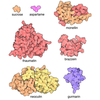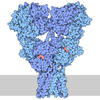[English] 日本語
 Yorodumi
Yorodumi- PDB-8x0f: Human FL Metabotropic glutamate receptor 5, mGlu5-5M with quisqua... -
+ Open data
Open data
- Basic information
Basic information
| Entry | Database: PDB / ID: 8x0f | ||||||||||||
|---|---|---|---|---|---|---|---|---|---|---|---|---|---|
| Title | Human FL Metabotropic glutamate receptor 5, mGlu5-5M with quisqualate and PAM VU29 | ||||||||||||
 Components Components | Metabotropic glutamate receptor 5 | ||||||||||||
 Keywords Keywords | MEMBRANE PROTEIN / G-PROTEIN COUPLED RECEPTORS / SIGNAL TRANSDUCTION / METABOTROPIC GLUTAMATE RECEPTOR / Agonist / active state | ||||||||||||
| Function / homology |  Function and homology information Function and homology informationA2A adenosine receptor binding / G protein-coupled receptor activity involved in regulation of postsynaptic membrane potential / trans-synaptic signaling by endocannabinoid, modulating synaptic transmission / adenylate cyclase inhibiting G protein-coupled glutamate receptor activity / phospholipase C-activating G protein-coupled glutamate receptor signaling pathway / neurotransmitter receptor activity involved in regulation of postsynaptic cytosolic calcium ion concentration / positive regulation of long-term neuronal synaptic plasticity / desensitization of G protein-coupled receptor signaling pathway / astrocyte projection / G protein-coupled glutamate receptor signaling pathway ...A2A adenosine receptor binding / G protein-coupled receptor activity involved in regulation of postsynaptic membrane potential / trans-synaptic signaling by endocannabinoid, modulating synaptic transmission / adenylate cyclase inhibiting G protein-coupled glutamate receptor activity / phospholipase C-activating G protein-coupled glutamate receptor signaling pathway / neurotransmitter receptor activity involved in regulation of postsynaptic cytosolic calcium ion concentration / positive regulation of long-term neuronal synaptic plasticity / desensitization of G protein-coupled receptor signaling pathway / astrocyte projection / G protein-coupled glutamate receptor signaling pathway / Class C/3 (Metabotropic glutamate/pheromone receptors) / glutamate receptor activity / Neurexins and neuroligins / protein tyrosine kinase activator activity / regulation of synaptic transmission, glutamatergic / positive regulation of calcium-mediated signaling / protein tyrosine kinase binding / dendritic shaft / learning / locomotory behavior / G protein-coupled receptor activity / synapse organization / postsynaptic density membrane / Schaffer collateral - CA1 synapse / cognition / cellular response to amyloid-beta / chemical synaptic transmission / G alpha (q) signalling events / dendritic spine / positive regulation of MAPK cascade / learning or memory / neuronal cell body / protein phosphorylation / dendrite / regulation of DNA-templated transcription / glutamatergic synapse / identical protein binding / plasma membrane / cytoplasm Similarity search - Function | ||||||||||||
| Biological species |  Homo sapiens (human) Homo sapiens (human) | ||||||||||||
| Method | ELECTRON MICROSCOPY / single particle reconstruction / cryo EM / Resolution: 3.3 Å | ||||||||||||
 Authors Authors | Vinothkumar, K.R. / Lebon, G. / Cannone, G. | ||||||||||||
| Funding support |  India, India,  France, 3items France, 3items
| ||||||||||||
 Citation Citation |  Journal: To Be Published Journal: To Be PublishedTitle: Conformational diversity in class C GPCR positive allosteric modulation Authors: Vinothkumar, K.R. / Lebon, G. / Cannone, G. | ||||||||||||
| History |
|
- Structure visualization
Structure visualization
| Structure viewer | Molecule:  Molmil Molmil Jmol/JSmol Jmol/JSmol |
|---|
- Downloads & links
Downloads & links
- Download
Download
| PDBx/mmCIF format |  8x0f.cif.gz 8x0f.cif.gz | 310.8 KB | Display |  PDBx/mmCIF format PDBx/mmCIF format |
|---|---|---|---|---|
| PDB format |  pdb8x0f.ent.gz pdb8x0f.ent.gz | 246.2 KB | Display |  PDB format PDB format |
| PDBx/mmJSON format |  8x0f.json.gz 8x0f.json.gz | Tree view |  PDBx/mmJSON format PDBx/mmJSON format | |
| Others |  Other downloads Other downloads |
-Validation report
| Summary document |  8x0f_validation.pdf.gz 8x0f_validation.pdf.gz | 1.5 MB | Display |  wwPDB validaton report wwPDB validaton report |
|---|---|---|---|---|
| Full document |  8x0f_full_validation.pdf.gz 8x0f_full_validation.pdf.gz | 1.5 MB | Display | |
| Data in XML |  8x0f_validation.xml.gz 8x0f_validation.xml.gz | 64.1 KB | Display | |
| Data in CIF |  8x0f_validation.cif.gz 8x0f_validation.cif.gz | 95.4 KB | Display | |
| Arichive directory |  https://data.pdbj.org/pub/pdb/validation_reports/x0/8x0f https://data.pdbj.org/pub/pdb/validation_reports/x0/8x0f ftp://data.pdbj.org/pub/pdb/validation_reports/x0/8x0f ftp://data.pdbj.org/pub/pdb/validation_reports/x0/8x0f | HTTPS FTP |
-Related structure data
| Related structure data |  37977MC  8x0bC  8x0cC  8x0dC  8x0eC  8x0gC  8x0hC C: citing same article ( M: map data used to model this data |
|---|---|
| Similar structure data | Similarity search - Function & homology  F&H Search F&H Search |
- Links
Links
- Assembly
Assembly
| Deposited unit | 
|
|---|---|
| 1 |
|
- Components
Components
| #1: Protein | Mass: 93691.492 Da / Num. of mol.: 2 / Mutation: T742A, S753A, T777A, I799A, A813L,N445A,H350L Source method: isolated from a genetically manipulated source Details: The construct has tags and protease cleavage site at its N-term (DYKDDDDKHHHHHHHHHHLEVLFQGP) and when compared to uniprot it starts at 21 and ends at 856. For CryoEM, the tag is cleaved and ...Details: The construct has tags and protease cleavage site at its N-term (DYKDDDDKHHHHHHHHHHLEVLFQGP) and when compared to uniprot it starts at 21 and ends at 856. For CryoEM, the tag is cleaved and the protein used for experiment starts at QSSE but residues starting RR have been modeled. There are 5 thermostabilising mutations (T742A, S753A, T777A, I799A, A813L). Residue N445 is mutated to remove glycosylation. An additional mutation H350L is engineered for a nanobody to bind. Each monomer has one sugar modelled and 10 disulfide bonds. Source: (gene. exp.)  Homo sapiens (human) / Gene: GRM5 / Plasmid: BacMam / Cell line (production host): HEK293S GnTI- / Production host: Homo sapiens (human) / Gene: GRM5 / Plasmid: BacMam / Cell line (production host): HEK293S GnTI- / Production host:  Homo sapiens (human) / References: UniProt: P41594 Homo sapiens (human) / References: UniProt: P41594#2: Sugar | #3: Chemical | #4: Chemical | ChemComp-XRQ / | Mass: 384.387 Da / Num. of mol.: 1 / Source method: obtained synthetically / Formula: C22H16N4O3 / Feature type: SUBJECT OF INVESTIGATION Has ligand of interest | Y | Has protein modification | Y | |
|---|
-Experimental details
-Experiment
| Experiment | Method: ELECTRON MICROSCOPY |
|---|---|
| EM experiment | Aggregation state: PARTICLE / 3D reconstruction method: single particle reconstruction |
- Sample preparation
Sample preparation
| Component | Name: Human FL Metabotropic glutamate receptor 5, mGlu5-5M with quisqualate and VU029 Type: COMPLEX / Entity ID: #1 / Source: RECOMBINANT | ||||||||||||||||||||
|---|---|---|---|---|---|---|---|---|---|---|---|---|---|---|---|---|---|---|---|---|---|
| Molecular weight | Value: 0.2 MDa / Experimental value: NO | ||||||||||||||||||||
| Source (natural) | Organism:  Homo sapiens (human) Homo sapiens (human) | ||||||||||||||||||||
| Source (recombinant) | Organism:  Homo sapiens (human) / Cell: HEK293S GnTI- / Plasmid: BacMam Homo sapiens (human) / Cell: HEK293S GnTI- / Plasmid: BacMam | ||||||||||||||||||||
| Buffer solution | pH: 7.4 | ||||||||||||||||||||
| Buffer component |
| ||||||||||||||||||||
| Specimen | Conc.: 5 mg/ml / Embedding applied: NO / Shadowing applied: NO / Staining applied: NO / Vitrification applied: YES Details: Receptor is purified in detergent micelles and monodisperse. The receptor is purified with 10 uM Quisqualate and 10 uM PAM VU29 | ||||||||||||||||||||
| Specimen support | Grid material: GOLD / Grid mesh size: 300 divisions/in. / Grid type: Quantifoil R0.6/1 | ||||||||||||||||||||
| Vitrification | Instrument: LEICA EM GP / Cryogen name: ETHANE / Humidity: 95 % / Chamber temperature: 277 K |
- Electron microscopy imaging
Electron microscopy imaging
| Experimental equipment |  Model: Titan Krios / Image courtesy: FEI Company |
|---|---|
| Microscopy | Model: FEI TITAN KRIOS Details: Data was collected in EFTEM model with selectris and Falcon 4i |
| Electron gun | Electron source:  FIELD EMISSION GUN / Accelerating voltage: 300 kV / Illumination mode: FLOOD BEAM FIELD EMISSION GUN / Accelerating voltage: 300 kV / Illumination mode: FLOOD BEAM |
| Electron lens | Mode: BRIGHT FIELD / Nominal magnification: 165000 X / Calibrated magnification: 192572 X / Nominal defocus max: 1200 nm / Nominal defocus min: 500 nm / Cs: 2.7 mm / C2 aperture diameter: 50 µm / Alignment procedure: COMA FREE |
| Specimen holder | Cryogen: NITROGEN / Specimen holder model: FEI TITAN KRIOS AUTOGRID HOLDER |
| Image recording | Average exposure time: 4.3 sec. / Electron dose: 49.62 e/Å2 / Film or detector model: FEI FALCON IV (4k x 4k) / Num. of grids imaged: 1 / Num. of real images: 9469 Details: Electron flux was 6.1. e/p/s. total number of frames per movie were 1395 |
| Image scans | Sampling size: 14 µm / Width: 4096 / Height: 4096 |
- Processing
Processing
| EM software |
| ||||||||||||||||||||||||||||
|---|---|---|---|---|---|---|---|---|---|---|---|---|---|---|---|---|---|---|---|---|---|---|---|---|---|---|---|---|---|
| CTF correction | Type: PHASE FLIPPING AND AMPLITUDE CORRECTION | ||||||||||||||||||||||||||||
| Particle selection | Num. of particles selected: 1418090 | ||||||||||||||||||||||||||||
| Symmetry | Point symmetry: C1 (asymmetric) | ||||||||||||||||||||||||||||
| 3D reconstruction | Resolution: 3.3 Å / Resolution method: FSC 0.143 CUT-OFF / Num. of particles: 113563 / Algorithm: BACK PROJECTION / Symmetry type: POINT | ||||||||||||||||||||||||||||
| Atomic model building | B value: 121.7 / Protocol: OTHER / Space: REAL | ||||||||||||||||||||||||||||
| Atomic model building | Accession code: D_1300042377 / Details: Model from this deposition was used as template / Source name: Other / Type: experimental model | ||||||||||||||||||||||||||||
| Refine LS restraints |
|
 Movie
Movie Controller
Controller








 PDBj
PDBj





